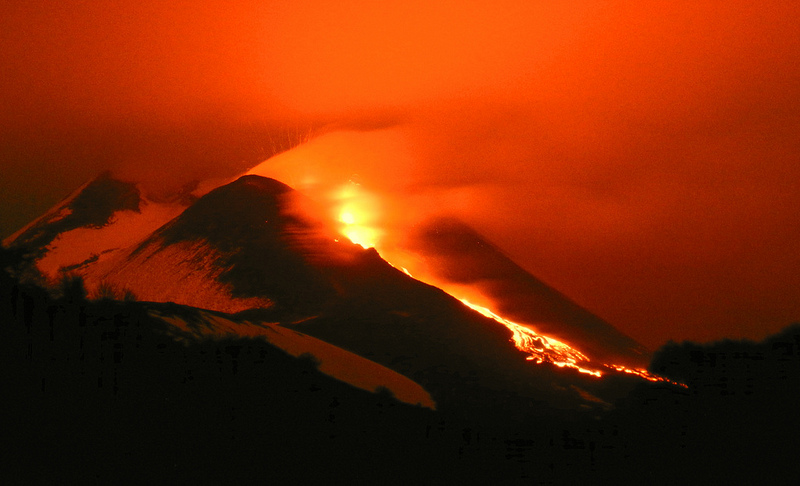One of Earth's Most Active Volcanoes Named World Heritage Site

Sicily's Mount Etna, one of the most active volcanoes on the planet, has been inscribed as a UNESCO World Heritage Site, the committee that makes the selections announced today (June 21) from their annual meeting, taking place this year in Cambodia.
The iconic volcano — the most active stratovolcano in the world — has been added, along with several other sites, to the list of some 969 natural and cultural heritage sites that have "outstanding universal value," according to the UNESCO (United Nations Educational, Scientific and Cultural Organization) website. The criteria for inclusion on the list include a range of factors, such as being an area of "exceptional natural beauty," a valuable relic of an ancient or still-existent culture, or, like Etna, an example of "significant on-going geological processes."
The list is meant to encourage countries that sign on to the World Heritage Convention to protect the sites within their boundaries. When a site is endangered by environmental concerns, which has been the case with Australia's Great Barrier Reef, or by conflict, like important cultural sites in Syria are by the civil war there, the committee lists them on their World Heritage in Danger list.
Iconic volcano
Mount Etna was placed on the list because of its status as an iconic volcano and an excellent natural laboratory to study geological processes. The committee cites the volcano's long eruptive history, which can be traced back 500,000 years and has been recorded by humans going back some 2,700 years. The area included in the Etna World Heritage Site encompasses some 47,536 uninhabited acres (19,237 hectares) on the highest part of the peak. [Photos: New World Heritage Sites]
Along with Etna, several other natural sites were added to the list. Tajikistan National Park (also called the Mountains of Pamir) features the point where the highest mountains in Eurasia meet, called the "Pamir Knot." The sparsely inhabited region features the longest valley glacier outside of Earth's poles and features many rare and threatened species, such as the Marco Polo Argali sheep, snow leopards and the Siberian ibex, according to a UNESCO statement. Because of its geologic setting and frequent earthquakes, the area "offers a unique opportunity for the study of plate tectonics and subduction phenomena," the statement said.
Mexico's El Pinacate and Gran Desierto de Altar Biosphere Reserve was also inscribed on the list. It features two distinct parts, the black and red lava flows and desert pavements of the dormant Pinacante Shield volcanic region and the Gran Altar Desert, with sand dunes that can reach 650 feet (200 meters) high. UNESCO calls the site one of "dramatic beauty … whose exceptional combination of features are of great scientific interest."
Get the world’s most fascinating discoveries delivered straight to your inbox.
China's Xinjiang Tianshan, which encompasses part of the Tianshan mountain system and the Taklimakan Desert, one of the world’s largest and highest deserts, was also added, along with the Namib Sand Sea in Namibia. It is "the only coastal desert in the world that includes extensive dune fields influenced by fog," UNESCO said.
Two cultural World Heritage Sites have also been inscribed: the Hill Forts of Rajasthan in India, and the wooden tserkvas (or churches) built by Eastern Orthodox and Greek Catholics in parts of Poland and Ukraine from the 16th through the 19th centuries. The churches were cited for their representation of a "distinct building tradition." The hill forts were built during the rule of the Rajput princely states from the eighth through the 18th centuries and feature "eclectic architecture," UNESCO said.
Sites in danger
The committee also listed several sites on its Danger list, particularly the six World Heritage Sites located in war-torn Syria: the Ancient City of Damascus: Site of Palmyra; the Ancient City of Bosra; the Ancient City of Aleppo; Crac des Chevaliers and Qal’at Salah El-Din; and the Ancient Villages of Northern Syria. The move was taken "so as to draw attention to the risks they are facing because of the situation in the country," UNESCO said.
The committee had warned the governments of Australia and Queensland that it would place the iconic Great Barrier Reef on the Danger list because of concerns over development of ports and increased shipping in the area of the reef. The committee passed a resolution on Tuesday (June 18) to recommend adding the reef to the list next year if its concerns are not met by government action, according to the Sydney Morning Herald.
The World Heritage Committee will meet in Cambodia through June 27.
Follow Andrea Thompson @AndreaTOAP, Pinterest and Google+. Follow OurAmazingPlanet @OAPlanet, Facebook and Google+.Original article at LiveScience's OurAmazingPlanet.

Andrea Thompson is an associate editor at Scientific American, where she covers sustainability, energy and the environment. Prior to that, she was a senior writer covering climate science at Climate Central and a reporter and editor at Live Science, where she primarily covered Earth science and the environment. She holds a graduate degree in science health and environmental reporting from New York University, as well as a bachelor of science and and masters of science in atmospheric chemistry from the Georgia Institute of Technology.
